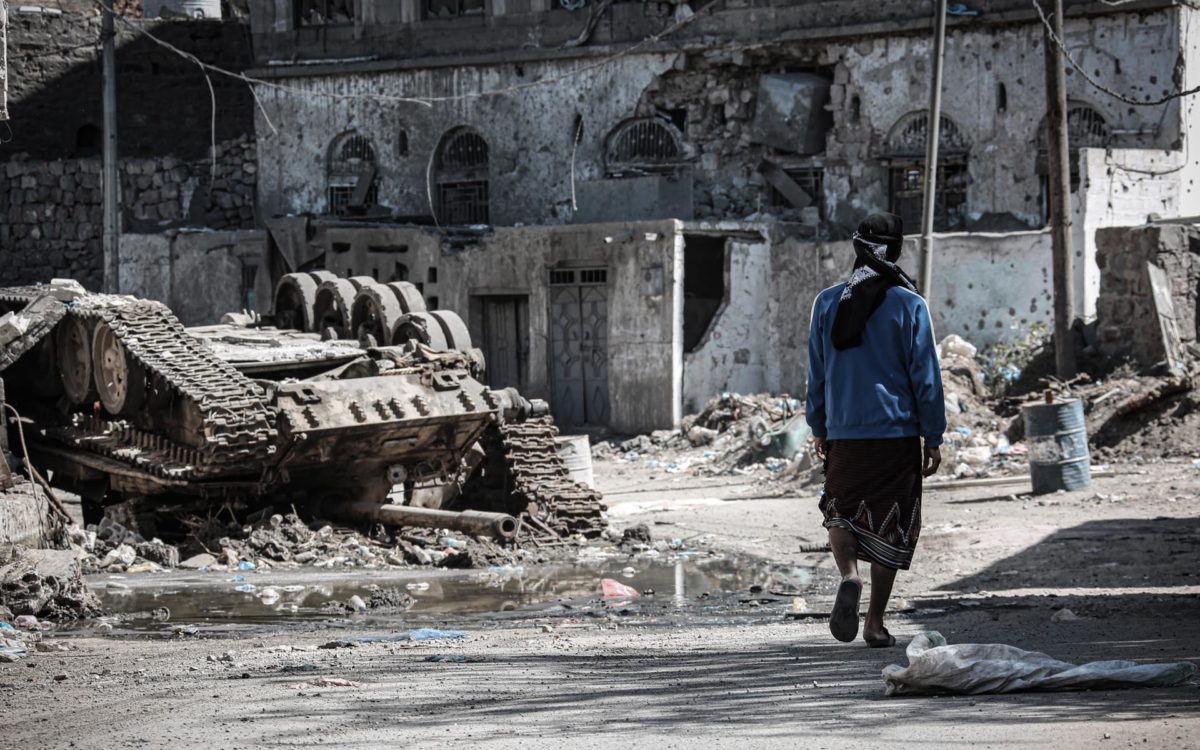
Elena Simon
‘To conceptualise ‘civilian life’ as the backdrop of violent conflict creates a continuum of civilian life/violence/civilian life…. This continuum foreclosed any questions about the violent structures inherent to ‘civil’ society and leading up to as well as out of the armed conflict…’
My research started as a question about how civil-military relationships are being produced in the everyday. I start with the irritating story, published in 2006, of a man who used to produce and export gallows from his UK farm. When asked by journalists how and why he got into this business, he reportedly answered ‘business is business‘. The export of execution equipment was banned in the EU in July 2006, but a question stuck with me, since I read this story. How can it be that ordinary citizens produce means of violence, and don’t think about their own involvement in its occurrence?
‘Civil wars’ are defined as armed conflicts between persons and groups that are not authorised by law to the use of lethal force. It is conventionally seen as the wars in which ‘ordinary’ people, often quite inexplicably, turn against each other. The inexplicability that is curated in media reporting on civil wars, reflects my own initial irritation with the gallows producer. But it is not an accidental irritation. Rather, I think, it highlights the workings of ‘the civil’ as a concept circulating in society that forecloses curiosity about it. While the military, violence, and soldiering catch our attention, the supposed banality of ‘the civil’ renders it into a background that escapes scrutiny.
Militarisation as a fruitful concept…
Militarisation has been a very influential and productive concept. Cynthia Enloe defined militarisation as ‘a step-by-step process by which a person or a thing gradually comes to be controlled by the military or comes to depend for its well-being on militaristic ideas’. Militarisation opened to investigation the process by which beliefs about the superior capacity of military to solve or manage societal problems are spread through society. Militarisation addressed at the same time how gendered assumptions are necessarily built into this process and stabilised through the material relationships that are reproduced by those assumptions. Cynthia Enloe’s work inspired a generation of critical and feminist researchers (including myself) to pay close attention to those power structures.
In the process, we have learned a lot about how the military as institution manages gendered views and relations and mobilises these to increase funding, public acceptance and the belief that the world could not do without it. As Cynthia Enloe says poignantly: militarisation ‘creeps into our everyday lives‘.
… tells only half the story
It is at this point where more recent debates raise doubts and where my thought process starts. To militarise something means that whatever it was, was previously not militarised and somehow untouched by the logic of militarism. It constitutes the military logic as something outside of society, and militarisation as the driving force that shapes how society looks like. Can we really view any site of collective existence as so completely independent from others? If there are distinct logics to military and its Other, who is reproducing those and how? Where is the agency of those who are ‘being militarised’ in this process?
I’m inspired to ask these questions by Frigga Haug’s 1980 lecture with the provocative title ‘Women – Victims or Culprits?‘. This empathic, self-critical and thoughtful essay on self-actualisation challenges the view that women are passive receivers of their own socialisation and that society could change without women changing at the same time. Instead, it offers a radical endorsement of women’s agency and highlights how women not only knit on the webs of their own oppression, but how this change in perspective places the power to transform oppressive structures into the hands of women collectively.

The civilian has no agency
Diving into these questions unearths several irritations. First, the agency in the dichotomous world of military and civilians is unequally distributed. The civilian, as constituted by international treaties, has no agency or independent existence from the combatant – indeed legally speaking a civilian is a ‘non-combatant’. The civilian is not part of an armed group, not wearing uniforms, nor carrying weapons, and as Helen Kinsella shows, cannot have a political project without losing the status of ‘civilian’. Loyalty to whichever is the dominant armed group in a conflict, Kinsella finds, plays a huge role in determining who is deemed worthy of being a ‘civilian’. Knowing which armed group currently controls the territory, thus becomes a survival strategy for people living in a territory of armed conflict.
Thus, the status of ‘civilian’ is in flux and does not guarantee protection. Kinsella provides ample examples from civil wars to anti-imperialist struggles that highlight how visibility of ‘civilian’ or ‘non-combative’ features only superficially establish and govern the category of ‘the civilian”. At the same time those have been used as a form of subversion and camouflage, and the potential misuse of civilian aesthetics has been mobilised to declare casualties as combatants. Protection of civilians (PoC) has thus never existed as an unqualified principle.
A critical history of the civilian traces the birth of the civilian through the elimination of the citizen during war in 19th century legal documents. As industrialisation changed the geography of warfare and generated demand for labour power, the rules of ‘civilised warfare’ changed and gave rise to discourses on the protection of valuable assets during occupation. However, defining the persons in occupied territories as citizens meant that those unruly citizens put forward demands for political representation, ownership and at times even dared to organise a counterattack. Thus, in the wake of industrialised warfare the citizen was abolished and a new figure appeared. In these discourses the civilian first enters the scene as someone who is unarmed, completely uninvolved in war and thus in need of protection, and it is then when the stereotypical representation of civilians as women and children starts. At the same time this new figure becomes a valuable military target and a site of moral superiority, with which imperialist countries could threaten their enemies down. The point Amanda Alexander makes is that the status of ‘civilian’ had less to do with a moral code to protect people than it had to do with providing a moral narrative for warring parties.
Thus, the civilian as reproduced in legal documents is a static figure, who is not acting, but acted upon. In this sense the civilian appears as the feminised and objectified Other that justifies the existence of military dominance.
There is no ‘civilian life’ to return to
The second irritation is that ‘the civilian’ is a very elusive figure. It only appears during war. We hear about ‘civilian casualties’, and we see ‘civilian suffering’, but as soon as the ‘civilian’ who needs protection starts moving, they become internally displaced persons, or refugees and become subject to law-enforcement and, tragically, victimised by military border patrols. There is no account for where the civilian goes ‘after’ war, or what they have been up to before the war. The combatant, after armed conflict, is ‘returning to civilian life’, which is often imagined as a life of ‘innocence’ and nonviolent participation in a ‘civil society’ that establishes a third sphere, independent from the state and economic interests. But if the civilian is only a category of war, and a very elusive one at that, where exactly is it that they do go? To conceptualise ‘civilian life’ as the backdrop of violent conflict creates a continuum of civilian life/violence/civilian life. It reproduces a notion of innocence and an idyll of society unchanged and untouched by violent conflict which does not seem to be based on people’s lived experience or historical facts. This continuum also foreclosed any questions about the violent structures inherent to ‘civil’ society and leading up to as well as out of the armed conflict. It is thus at the point of unpacking this continuum at which my work intersects with the Civil War Paths project.
The ‘civil’ as a productive force
This leads me to conclude that it is ‘the civil” that needs our attention. I think we need to reconsider what seems ‘outside’ of militarisation and conceptualise whatever it is that is changed by militarisation to render visible the ways militarism is being constituted by ‘it’. It is ‘the civil” in ‘civil society’; the ‘civil’ that the police claims to be part of and that demarcates the line between ‘military production’ and ‘civil/commercial markets’. A way to do that is to reflect on agency and ‘the civil’ and trace what work it is doing in establishing the dualism of civil/military. Rather than militarism creeping into our everyday lives – how is it that we take part in producing the dualism of civil/military in the first place and how do we reproduce ‘the civil’ as this site of innocence?

